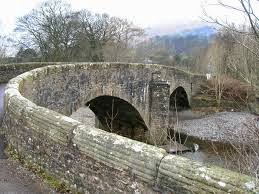This morning is a little quiet, a good opportunity for catching up on various jobs although for the present I am thinking very happily of the time I had with my grand-children this time last week.
The focus of our activity was a wooden toy train set. These are very popular in Britain for developing a wide range of skills including (through the way carriages are joined together), an understanding of magnets.
Undaunted by its educational possibilities, within a few moments I found myself sitting on the floor, putting the various pieces of track together to make a layout. This is not something that I am particularly good at. Whereas other family members are always able to produce a circuit, my attempts reflect the way my mind works, to ramble on, eventually running out of the right pieces and one end usually disappearing under a sofa.
When all the pieces are in place "Little Brother" is moved beyond grabbing distance because among all the
many hazards endured by the railway network, such as "leaves on the line" and "the wrong type of snow", perhaps the most alarming is to be placed in a baby's mouth. At some point however it will become clear to my grand-son what all these different pieces are for.
It may seem a little narrow sometimes, although the purpose of any clearly defined track is to make things easier. In life there will also be obstacles, uneven ground, furniture and rugs to work around. Perhaps those Victorian Quakers who were so actively involved in the railway, had a particular understanding of the need to prioritise our surroundings. Through careless feet and unreasonable babies, there could also be a sense of injustice. In these instances we have a choice, either to keel over onto the carpet or experience bravery and persistence. Life is intended to be worked at. Our course through it will need regular maintaining.

Once the railway is complete, my grand-daughter likes to take control. She will place her
engine on the track, align various wagons and carriages behind it and, assisted by the magnets in their buffers, push them gently
together. Although we do not as yet have a platform (or passengers) since trains move forwards and backwards, our passengers (who may only be imagined) already have the dilemma of not knowing in advance where to expect first class. They may run to the front or the back, or more wait hopefully somewhere in the middle. With trains, especially trains that manage to arrive on time, it is enough just to be there. As in life, we may have expectations, only to find ourselves humbled.
It takes some practice fitting wagons and carriages together. At times carriages seem in harmony, all being pulled along together in the right direction. There are however other instances when instead of seeming attracted to each other, carriages back off in quite the opposite direction. For some mysterious reason no amount of pushing can bring them together.
.
At times it is easy for us to forget the magnetic side of human nature which instinctively responds to the presence of God and pulls in the right direction. Those instances when it all seems to be going wrong are only an opportunity to stop, reassess the situation and gradually turn your carriages around.In many faiths this process of transformation by changing direction is called "repentance." I like to think we are prepared to do this often among Quakers.
Within our meetings there may be a temptation for everyone to think of themselves as an engine, invested with the right and ability to negotiate their own course through life. Since we have no clearly defined hierarchy, our search for humility may be the most difficult part of the journey. With each point and each moment there is a choice.

The right engine will help carriages stay on the rails, just as with life. Choosing the right one is often the result of background. To those adults looking for perfection, a 1930's steam engine might look a little strange pulling carriages designed for the Channel tunnel. A child however might use an entirely different set of criteria such as colour or the ability to go under a particular type of bridge. In life and as on certain toy railway layouts, this can be a bit of a problem. Among Quakers some may look exclusively to follow Jesus whilst others deliberately look to the insights of other faiths. As with life, the test of any toy engine is to see if the magnet works and where it chooses to take you.
With each moment and experience there is an opportunity to learn something new. We may not get things right first time, and need to practice certain skills. It is just as well that life also has a tendency to go round in circles. All the time there is a choice about the direction in which we choose to face and whether or not to hold on.
My grand-daughter has a very good imagination. Her train always goes to the seaside, and to the zoo. Sometimes the route is a little more mundane although "shopping", especially "toy-shopping", can be a very exciting experience to a child. Her little toy train is gently guided to experience wonder, given time to learn from experience and so through this journey of discovery, gain the things that it needs- as in life.

















